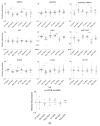Statins Aggravate the Risk of Insulin Resistance in Human Muscle
- PMID: 35216514
- PMCID: PMC8876152
- DOI: 10.3390/ijms23042398
Statins Aggravate the Risk of Insulin Resistance in Human Muscle
Abstract
Beside their beneficial effects on cardiovascular events, statins are thought to contribute to insulin resistance and type-2 diabetes. It is not known whether these effects are long-term events from statin-treatment or already triggered with the first statin-intake. Skeletal muscle is considered the main site for insulin-stimulated glucose uptake and therefore, a primary target for insulin resistance in the human body. We analyzed localization and expression of proteins related to GLUT4 mediated glucose uptake via AMPKα or AKT in human skeletal muscle tissue from patients with statin-intake >6 months and in primary human myotubes after 96 h statin treatment. The ratio for AMPKα activity significantly increased in human skeletal muscle cells treated with statins for long- and short-term. Furthermore, the insulin-stimulated counterpart, AKT, significantly decreased in activity and protein level, while GSK3ß and mTOR protein expression reduced in statin-treated primary human myotubes, only. However, GLUT4 was normally distributed whereas CAV3 was internalized from plasma membrane around the nucleus in statin-treated primary human myotubes. Statin-treatment activates AMPKα-dependent glucose uptake and remains active after long-term statin treatment. Permanent blocking of its insulin-dependent counterpart AKT activation may lead to metabolic inflexibility and insulin resistance in the long run and may be a direct consequence of statin-treatment.
Keywords: AKT; AMPK; human skeletal muscle; insulin resistance; primary human muscle cells; statins.
Conflict of interest statement
The authors declare no conflict of interest.
Figures





Similar articles
-
Mechanisms of insulin resistance by simvastatin in C2C12 myotubes and in mouse skeletal muscle.Biochem Pharmacol. 2019 Jun;164:23-33. doi: 10.1016/j.bcp.2019.02.025. Epub 2019 Feb 20. Biochem Pharmacol. 2019. PMID: 30796916
-
Rosemary extract activates AMPK, inhibits mTOR and attenuates the high glucose and high insulin-induced muscle cell insulin resistance.Appl Physiol Nutr Metab. 2021 Jul;46(7):819-827. doi: 10.1139/apnm-2020-0592. Epub 2021 Jan 20. Appl Physiol Nutr Metab. 2021. PMID: 33471600
-
Chronic mTOR inhibition by rapamycin induces muscle insulin resistance despite weight loss in rats.Br J Pharmacol. 2012 Apr;165(7):2325-40. doi: 10.1111/j.1476-5381.2011.01716.x. Br J Pharmacol. 2012. PMID: 22014210 Free PMC article.
-
10-Hydroxy-2-decenoic acid, a unique medium-chain fatty acid, activates 5'-AMP-activated protein kinase in L6 myotubes and mice.Mol Nutr Food Res. 2013 Oct;57(10):1794-802. doi: 10.1002/mnfr.201300041. Epub 2013 Jun 10. Mol Nutr Food Res. 2013. PMID: 23754629
-
Metabolism and insulin signaling in common metabolic disorders and inherited insulin resistance.Dan Med J. 2014 Jul;61(7):B4890. Dan Med J. 2014. PMID: 25123125 Review.
Cited by
-
Effects of genetically proxied statins on diabetic nephropathy and retinopathy: a Mendelian randomization study.Sci Rep. 2024 Jul 23;14(1):16885. doi: 10.1038/s41598-024-67800-5. Sci Rep. 2024. PMID: 39043809 Free PMC article.
-
The pharmacological bases for repurposing statins in depression: a review of mechanistic studies.Transl Psychiatry. 2023 Jul 12;13(1):253. doi: 10.1038/s41398-023-02533-z. Transl Psychiatry. 2023. PMID: 37438361 Free PMC article. Review.
-
Highlights in Pathophysiology of the Musculoskeletal System.Int J Mol Sci. 2023 Mar 29;24(7):6412. doi: 10.3390/ijms24076412. Int J Mol Sci. 2023. PMID: 37047383 Free PMC article.
-
Daidzein improves muscle atrophy caused by lovastatin by regulating the AMPK/FOXO3a axis.Chin Med. 2024 Dec 31;19(1):180. doi: 10.1186/s13020-024-01034-5. Chin Med. 2024. PMID: 39741316 Free PMC article.
-
Exenatide prevents statin-related LDL receptor increase and improves insulin secretion in pancreatic beta cells (1.1E7) in a protein kinase A-dependent manner.J Appl Biomed. 2022 Dec;20(4):130-140. doi: 10.32725/jab.2022.015. Epub 2022 Nov 22. J Appl Biomed. 2022. PMID: 36708718
References
-
- Khan S.U., Rahman H., Okunrintemi V., Riaz H., Khan M.S., Sattur S., Kaluski E., Lincoff A.M., Martin S.S., Blaha M.J. Association of Lowering Low-Density Lipoprotein Cholesterol With Contemporary Lipid-Lowering Therapies and Risk of Diabetes Mellitus: A Systematic Review and Meta-Analysis. J. Am. Heart Assoc. 2019;8:e011581. doi: 10.1161/JAHA.118.011581. - DOI - PMC - PubMed
-
- Ko M.J., Jo A.J., Kim Y.J., Kang S.H., Cho S., Jo S., Park C., Yun S., Lee W.J., Park D. Time- and Dose-Dependent Association of Statin Use With Risk of Clinically Relevant New-Onset Diabetes Mellitus in Primary Prevention: A Nationwide Observational Cohort Study. J. Am. Heart Assoc. 2019;8:e011320. doi: 10.1161/JAHA.118.011320. - DOI - PMC - PubMed
MeSH terms
Substances
Grants and funding
LinkOut - more resources
Full Text Sources
Medical
Miscellaneous

